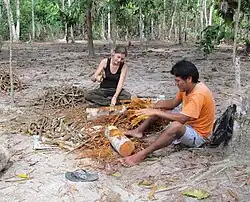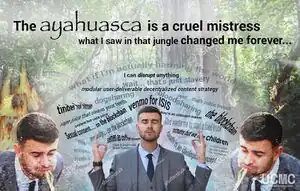Ayahuasca

| Dolphins and Money New Age |
| Cosmic concepts |
| Spiritual selections |
v - t - e
|
Ayahuasca (a.k.a. yagé) is a hallucinogenic and entheogenic concoction used ceremonially in certain native Peruvian and Brazilian religions. The use of ayahuasca was first described outside of South American communities in the 1950s by ethnobotanist Richard Evans Schultes.[1]
Users of ayahuasca describe having "profound life-changing spiritual experiences," and "a sense of inner peace and acceptance of self, others, and the world."[2] However, it also makes you vomit and shit, and basically feel terrible. At first you're afraid you're going to die, then you're afraid you're not going to die. In recent years, people from other countries have been traveling to South America to have such an experience. This is ayahuasca tourism. Some shamans charge a whole heap of money for their goods and services.
Pharmacology
The active ingredient is N,N-dimethyltriptamine![]() (DMT)[3], which is a Schedule I substance in the USA. DMT, also known as "the spirit molecule", is normally metabolized in the stomach by monoamine oxidase (MAO), and so never reaches the bloodstream; but those cunning shamans long ago discovered that a monoamine oxidase inhibitor (MAOI) prevents first pass metabolism of DMT, which in turn allows the full effect of the DMT to be felt. As luck would have it, DMT is plentiful in shrubs of the Psychotria genus, and MAOI can be found in a jungle vine of the Malpighiaceae family (e.g., Banisteriopsis caapi). Let the party begin.
(DMT)[3], which is a Schedule I substance in the USA. DMT, also known as "the spirit molecule", is normally metabolized in the stomach by monoamine oxidase (MAO), and so never reaches the bloodstream; but those cunning shamans long ago discovered that a monoamine oxidase inhibitor (MAOI) prevents first pass metabolism of DMT, which in turn allows the full effect of the DMT to be felt. As luck would have it, DMT is plentiful in shrubs of the Psychotria genus, and MAOI can be found in a jungle vine of the Malpighiaceae family (e.g., Banisteriopsis caapi). Let the party begin.
History
The use of psychoactive plants is known to have occurred in South America dates back thousands of years, specifically coca.[4][5] The ancient use ayahuasca has been claimed, seemingly without evidence.[6] However linguistic and folkloric evidence among indigenous South Americans indicates that its use is less than 500 years old,[7] and possibly only about 50 years according to anthropologist Bernd Brabec de Mori.[8] William Burroughs in his 1963 book The Yage Letters,![]() described using yage (another name for ayahuasca) in 1953, marking its use as older than 72 years.[9]
described using yage (another name for ayahuasca) in 1953, marking its use as older than 72 years.[9]
In recent years, ayahuasca use has been increasingly the subject of so-called "spiritual tourism" from non-indigenous populations.[1] The claim of ancient usage has also been used in its promotion to tourists.[10]
Benefits and dangers
Claimed benefits are roughly the same as for LSD and other psychedelic hallucinogens — namely, that it produces experiences described as being "spiritual" or "life-changing" in nature. MAPS has also conducted a preliminary observational study suggesting that ayahuasca may be helpful for treating certain aspects of addiction.[11]
Complications include death, cardiac arrhythmia caused by the harmala alkaloids, and acute psychosis.[12] Documented social dangers include rape of female ayahuascarians and, obviously, daylight robbery of the rich by the poor, which is arguably a benefit. There have been reports of other hallucinogens being mixed in (usually plants which contain scopolamine), to give the turistas "that extra buzz".
As the harmala alkaloids in ayahuasca are MAOIs, they strongly potentiate many prescription drugs.![]() Specifically, they allow serotonin re-uptake inhibitors to generate far greater levels of extracellular serotonin, which may cause serotonin syndrome
Specifically, they allow serotonin re-uptake inhibitors to generate far greater levels of extracellular serotonin, which may cause serotonin syndrome![]() or death in extreme cases. Participants are advised not to take drugs unless they're sure they do not interact with MAOIs.
or death in extreme cases. Participants are advised not to take drugs unless they're sure they do not interact with MAOIs.
Where to find it
- Iquitos, Peru (Blue Morpho is the popular spot)
- Varillal, Peru (Caya Shobo is the only western owned center endorsed by the Shipibo Konibo Tribal Council)
- Shimbre Shamanic Center, Tres Islas, Peru
- Yarina, Peru
- Pullcalpa, Peru (ceremonies with Lucho or Don Marcial)
- São Paulo, Brazil (ayawakening Personalized Retreats & Ceremonies in Brazil)
- Yurimaguas, Peru
- Barrio Florida, Peru
- Bogotá, Colombia
- La Chorrera, Colombia
- Mocoa, Colombia (but beware — if you die they won't give a shit)
- Kentucky, United States of America (Aya Quest Native American Church)
- Costa Rica, Peru, Ecuador (Retreat Directory)
Celebrity ayahuasca tourists

- William S. Burroughs[9]
- Terence McKenna
- Paul Simon
- Sting[note 1]
- Tori Amos
- Robin Quivers
- Graham Hancock (his Tedx ayahuasca talk was censored)
- Megan Fox and Machine Gun Kelly[13]
- Aaron Rodgers
- Techbros who think it will make them better techbros[14]
External links
- See the Wikipedia article on Legal status of ayahuasca by country.
- "Erowid Ayahuasca Vault" (retrieved October 2015)
- Think Twice Before Bringing Ayahuasca Back to the US After Your Retreat (retrieved August 2014)
- Stepping Into the Fire — documentary, mainly about the Shimbre Shamanic Center
- Kyle Nolan story from Mail Online 12 Sept 2012 (retrieved August 2013). Nolan died from ayahuasca in 2012 having paid $1200 for the experience.
- 50-min documentary Shamans of the Amazon by Dean Jefferys
- Web site promoting the film.
- New-Age proponent Taylor Marie talking about how ayahuasca changed her life.
- Taylor again, this time with clean hair, talking about how ayahuasca tourism has somewhat corrupted the "pure" experience.
- Ayaadvisor.org — an ayahuasca resource in the English language
- Online aya forums
- 5-min Video about the Gringo Shaman of the Amazon
- Ayahuasca: Grieving parents issue warning to backpackers after son's death on jungle drug retreat
- How an ayahuasca retreat claimed the life of a 24yo Kiwi tourist in the Amazon
- Peru's brutal murders renew focus on tourist boom for hallucinogenic brew
- Ayahuasca Retreats in Brazil with Yoga and Workshops for Spiritual Development
Notes
- ↑ Quote from his Rolling Stone interview: "There's a certain amount of dread attached to taking it. You have a hallucinogenic trip that deals with death and your mortality. So it's quite an ordeal. It's not something you're going to score and have a great time on."
References
- ↑ 1.0 1.1 Magnificent Visions by Ted Mann (November 11, 2011) Vanity Fair.
- ↑ Erowid Ayahuasca Vault
- ↑ Erowid info page
- ↑ "Early Holocene coca chewing in northern Peru" b Tom D. Dillehay et al. (2010) Antiquity 84(326). doi:10.1017/S0003598X00067004.
- ↑ Coca leaves first chewed 8,000 years ago, says research by Jason Palmer (2 December 2010) BBC News.
- ↑ Who Will Benefit From Psychedelic Medicine? These substances are being touted as a game-changing intervention for mental health. But it’s not clear if their promise will be accessible to all. by Whitney Joiner (September 21, 2020) The Washington Post.
- ↑ Is Ayahuasca Possibly Less than Five Hundred Years Old? by Bernd Brabec de Mori (June 18, 2020) Chacruna.
- ↑ The ancient psychedelics myth: ‘People tell tourists the stories they think are interesting for them’ by Manvir Singh (1 May 2025 00.00 EDT) The Guardian.
- ↑ 9.0 9.1 The Yage Letters by William S. Burroughs (2001). City Lights Publishers. ISBN 0872860043.
- ↑ Ayahuasca Shamanism The Temple of the Way of Light.
- ↑ See Ayahuasca-Assisted Therapy for Addiction: Results from a Preliminary Observational Study in Canada Current Drug Abuse Reviews August 2012 (retrieved October 2015)
- ↑ See The Dark Side of Ayahuasca: Kelly Hearn, Men's Journal March 2013 (retrieved August 2013)
- ↑ https://www.thecut.com/2021/07/megan-fox-mgk-ayahuasca-hell.html
- ↑ Silicon Valley's new craze is flying to Peru to take a psychedelic you can't legally get in America by Melia Robinson (Dec 6, 2016, 8:36 AM PST) Business Insider.